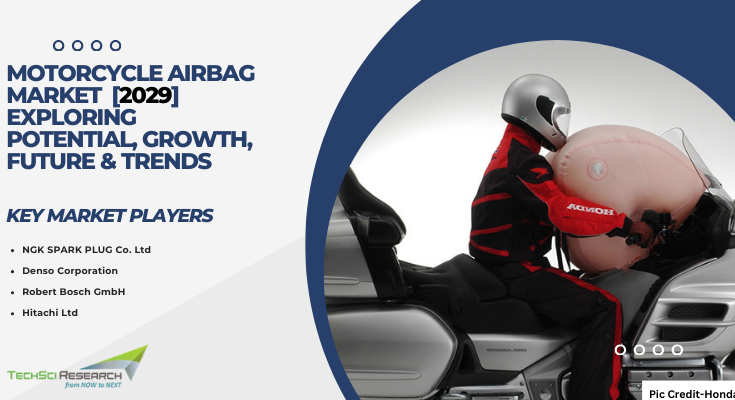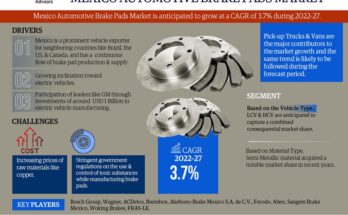According to TechSci Research report, “Global Motorcycle Airbag Market – Industry Size, Share, Trends, Competition Forecast & Opportunities, 2029”, the Global Motorcycle Airbag Market stood at USD 0.41 Billion in 2023 and is anticipated to grow with a CAGR of 8.05% in the forecast period, 2025-2029. The global motorcycle airbag market is experiencing a remarkable expansion as the demand for motorcycle safety measures continues to grow. This expansion can be attributed to various factors, including the steady increase in motorcycle usage, the heightened awareness of road safety among riders, and the implementation of stricter safety regulations by governing bodies. With more people embracing motorcycles as a means of transportation, the need for effective safety solutions has become paramount. Motorcycle airbags provide an additional layer of protection to riders, offering enhanced safety and reducing the risk of serious injuries in case of accidents. As the industry continues to evolve, manufacturers are constantly innovating to develop advanced airbag technologies that offer improved performance and reliability. With the ongoing advancements in motorcycle safety, riders can confidently enjoy their journeys knowing that they are well-protected on the road.
Key regions such as North America and Europe are pioneering advancements in motorcycle safety technology, largely due to the rigorous safety standards enforced by their regulatory bodies. For instance, the European Union has mandated the integration of advanced safety systems in two-wheelers, which has in turn boosted the motorcycle airbag market in the region.
The Asia-Pacific region, home to the largest population of motorcycle users, also presents a massive potential for market growth. Notably, the developing nations in the region are experiencing a surge in motorcycle sales, attributed to their growing economies and the convenience of two-wheelers in navigating through traffic-congested cities. However, the high cost of airbag systems and lack of stringent regulations could pose as a hurdle in the market’s growth in this region.
In terms of product type, the market is segmented into two parts: full body airbag and jacket airbag. While the full-body airbag provides a more comprehensive protection, the jacket airbag dominates the market due to its affordability and convenience.
Key players in the market include Alpinestars, Dainese S.p.A., HELITE, and Moto-Air. They are making significant investments in R&D, striving to engineer airbag systems that are more efficient, affordable, and adaptable to different motorbike models. On the technologic front, the advent of wireless airbag systems and the integration of IoT are expected to revolutionize the market landscape, paving way for opportunities in the near future.
Market forecasts indicate a promising outlook for the motorcycle airbag market. With ongoing advancements in safety technology and a growing global emphasis on road safety, the market is poised for robust growth in the coming years. Yet, it is crucial that manufacturers address the existing challenges, such as high cost and lack of awareness, to tap into the market’s full potential.
Browse over market data Figures spread through 180 Pages and an in-depth TOC on the “Global Motorcycle Airbag Market” @ https://www.techsciresearch.com/report/motorcycle-airbag-market/22023.html
The Global Motorcycle Airbag Market is undergoing a significant transformation, driven by a confluence of technological advancements, changing consumer preferences, and a growing emphasis on rider safety. One of the notable trends shaping the market is the integration of airbag systems with motorcycle apparel. Traditionally, airbag systems were primarily integrated into the motorcycles themselves, but a paradigm shift is occurring as manufacturers explore ways to incorporate airbag technology directly into motorcycle riding gear. This shift allows riders to experience the benefits of airbag protection irrespective of the motorcycle model they choose, promoting a more universal approach to safety in the motorcycling community.
A key aspect of this trend is the collaboration between airbag system manufacturers and apparel designers to create stylish, ergonomic riding gear that seamlessly incorporates airbag protection. Beyond the functional aspect of safety, the integration with motorcycle apparel emphasizes the importance of rider comfort and aesthetics. This trend aligns with the broader industry focus on enhancing the overall riding experience, making safety an integral and visually appealing part of the rider’s gear.
Another noteworthy trend in the Motorcycle Airbag Market is the growing adoption of wireless communication technologies. This trend represents a convergence of safety and connectivity, as airbag systems become more seamlessly integrated into the broader motorcycle safety ecosystem. Wireless communication enables real-time data exchange between various components, including the airbag system, motorcycle sensors, and the rider’s communication devices. This connectivity facilitates quicker and more precise responses to potential hazards, contributing to an enhanced overall safety profile for the rider.
Smart helmets with integrated airbag systems are emerging as a distinct trend in the market. These helmets, equipped with sensors and communication modules, go beyond traditional head protection by incorporating airbag technology. Smart helmets leverage accelerometers and gyroscopes to detect abnormal movements or sudden changes in speed, allowing for rapid deployment of airbags in the event of a collision. The integration of airbags into helmets underscores a comprehensive approach to rider safety, covering critical areas such as the head and neck. As smart helmet technologies continue to evolve, they are expected to become an integral component of the modern rider’s safety gear.
In addition to connectivity and smart technologies, the Motorcycle Airbag Market is witnessing a trend towards the development of more intelligent and adaptive systems through the incorporation of artificial intelligence (AI) and machine learning. These advanced technologies empower airbag systems to analyze a diverse set of data inputs, ranging from rider behavior to environmental conditions. AI-powered airbag systems can make real-time decisions regarding deployment, going beyond reactive responses to actively contribute to accident prevention. Machine learning algorithms enable these systems to continuously improve their predictive capabilities, adapting to individual rider patterns and enhancing overall safety.
Furthermore, a growing trend in the market is the customization and personalization of airbag systems to cater to individual rider preferences and needs. Motorcycle riders are a diverse community with unique requirements based on factors such as riding discipline, climate, and personal comfort. Manufacturers are responding to this diversity by offering modular airbag systems that allow riders to tailor the level of protection according to their preferences. Customizable airbag systems enable riders to adjust parameters such as deployment sensitivity, coverage area, and inflation speed, providing a personalized safety solution that meets individualized requirements.
Despite these promising trends, the Global Motorcycle Airbag Market faces a set of challenges that could influence its trajectory. One significant challenge is the cost implications associated with integrating airbag systems into motorcycles. Affordability is a critical factor for motorcycle buyers, particularly in emerging markets. The additional costs incurred in manufacturing, testing, and implementing airbag systems can pose a barrier to widespread adoption. Striking a balance between offering advanced safety features and maintaining cost-effectiveness is crucial to overcoming this challenge and ensuring that airbag technology becomes a standard rather than a premium feature in motorcycles.
Integration complexity and retrofitting challenges represent another hurdle for the Motorcycle Airbag Market. Motorcycle designs vary widely, and retrofitting older models with airbag systems requires innovative solutions that can adapt to diverse configurations. The challenge is to seamlessly integrate airbag technology into existing designs without compromising aesthetics, rider comfort, or maneuverability. Manufacturers need to invest in research and development to create universal retrofit solutions that can address the diverse range of motorcycle designs on the road.
Weight and design constraints also pose challenges to the market. Motorcycles are sensitive to weight, and any increase can affect handling, fuel efficiency, and overall performance. Striking a delicate balance between enhanced safety and minimal weight impact is a complex engineering task. Developing airbag systems that meet rigorous safety standards while minimizing weight requires continuous innovation in materials science and a holistic approach to motorcycle design that prioritizes both safety and performance.
Limited market awareness and education about the benefits of airbag systems represent a challenge for the Motorcycle Airbag Market. Many riders may be unfamiliar with the technology, harbor misconceptions, or perceive airbags as unnecessary accessories. Robust education and awareness campaigns are essential to dispel myths, address concerns, and highlight the tangible advantages of incorporating airbags into motorcycle gear. Overcoming this challenge requires collaborative efforts between manufacturers, advocacy groups, and regulatory bodies to foster a safety-conscious motorcycle culture.
Moreover, the Global Motorcycle Airbag Market encounters challenges arising from the variability in safety regulations and standards across different regions and countries. Adapting airbag technologies to meet the specific safety regulations of each market adds complexity to the manufacturing process. Harmonizing safety standards globally is crucial to facilitate a smoother adoption of airbag technologies without compromising safety or impeding market access. Overcoming these challenges requires collaborative efforts among manufacturers, regulatory bodies, and industry stakeholders to develop innovative, cost-effective solutions, streamline integration processes, and foster a culture of safety consciousness among motorcycle riders worldwide.
In conclusion, the Global Motorcycle Airbag Market is navigating through a transformative phase marked by integration with motorcycle apparel, the adoption of wireless communication technologies, the development of smart helmets, a focus on artificial intelligence and machine learning, and the customization of airbag systems. These trends underscore the industry’s commitment to innovation, connectivity, and rider-centric safety solutions. While challenges exist, including cost implications, integration complexity, and awareness gaps, the motorcycle airbag market is poised for continued growth as manufacturers and stakeholders collaboratively address these hurdles and work towards creating a safer and more connected riding experience for motorcycle enthusiasts worldwide.
Major companies operating in the Global Motorcycle Airbag Market are:
- Bering Moto
- Klim
- CLOVER IT S.r.l.
- Tucano Urbano
- Furygan
- Spidi
- Honda Motor Co., Ltd
- Alpinestars
- Dainese S.p.A.
To Download FREE Sample Pages of this Report📥 @ https://www.techsciresearch.com/sample-report.aspx?cid=22023
Customers can also request for 10% free customization on this report.
“The Global Motorcycle Airbag Market is witnessing a transformative evolution, marked by innovations that redefine rider safety. Integrated with motorcycle apparel, airbag systems offer universal protection, emphasizing a blend of style and safety. The industry embraces wireless communication, smart helmets, and AI, crafting intelligent, adaptive solutions. Customization caters to diverse rider preferences, enhancing the personalized riding experience. Despite challenges of cost and retrofitting complexity, the market is driven by a collective commitment to making airbag technology accessible, ensuring a safer and connected future for motorcyclists worldwide.” said Mr. Karan Chechi, Research Director with TechSci Research, a research-based management consulting firm.
“Motorcycle Airbag Market – Global Industry Size, Share, Trends, Opportunity, and Forecast, Segmented By Components (Airbag, Crash Sensor, Airbag ECU, Others), By Coating (Neoprene Coated, Silicone Coated, Non-Coated), By Fabric Type (Nylon, Polyester, Others), By Region, Competition, 2019-2029”, has evaluated the future growth potential of Global Motorcycle Airbag Market and provides statistics & information on market size, structure and future market growth. The report intends to provide cutting-edge market intelligence and help decision-makers take sound investment decisions. Besides, the report also identifies and analyzes the emerging trends along with essential drivers, challenges, and opportunities in the Global Motorcycle Airbag Market.
You may also read:
Gasoline Direct Injection (GDI) Market | [2029] Exploring Potential, Growth, Future & Trends
Automotive Seat Belt Pretensioner Market Analysis, Development [2029], Key Terms
Variable Valve Timing (VVT) Market [2029] – Analysis, Trends, & Insights
Table of Content-Motorcycle Airbag Market
- Introduction
1.1. Product Overview
1.2. Key Highlights of the Report
1.3. Market Coverage
1.4. Market Segments Covered
1.5. Research Tenure Considered
- Research Methodology
2.1. Objective of the Study
2.2. Baseline Methodology
2.3. Key Industry Partners
2.4. Major Association and Secondary Sources
2.5. Forecasting Methodology
2.6. Data Triangulation & Validation
2.7. Assumptions and Limitations
- Executive Summary
3.1. Market Overview
3.2. Market Forecast
3.3. Key Regions
3.4. Key Segments
- Impact of COVID-19 on Global Motorcycle Airbag Market
- Global Motorcycle Airbag Market Outlook
5.1. Market Size & Forecast
5.1.1. By Value
5.2. Market Share & Forecast
5.2.1. By Components Market Share Analysis (Airbag, Crash Sensor, Airbag ECU, Others)
5.2.2. By Coating Market Share Analysis (Neoprene Coated, Silicone Coated, Non-Coated)
5.2.3. By Fabric Type Market Share Analysis (Nylon, Polyester, Others)
5.2.4. By Regional Market Share Analysis
5.2.4.1. Asia-Pacific Market Share Analysis
5.2.4.2. Europe & CIS Market Share Analysis
5.2.4.3. North America Market Share Analysis
5.2.4.4. South America Market Share Analysis
5.2.4.5. Middle East & Africa Market Share Analysis
5.2.5. By Company Market Share Analysis (Top 5 Companies, Others – By Value, 2023)
5.3. Global Motorcycle Airbag Market Mapping & Opportunity Assessment
5.3.1. By Coating Market Mapping & Opportunity Assessment
5.3.2. By Component Market Mapping & Opportunity Assessment
5.3.3. By Fabric Type Market Mapping & Opportunity Assessment
5.3.4. By Regional Market Mapping & Opportunity Assessment
- Asia-Pacific Motorcycle Airbag Market Outlook
6.1. Market Size & Forecast
6.1.1. By Value
6.2. Market Share & Forecast
6.2.1. By Coating Market Share Analysis
6.2.2. By Component Market Share Analysis
6.2.3. By Fabric Type Market Share Analysis
6.2.4. By Country Market Share Analysis
6.2.4.1. China Market Share Analysis
6.2.4.2. India Market Share Analysis
6.2.4.3. Japan Market Share Analysis
6.2.4.4. Indonesia Market Share Analysis
6.2.4.5. Thailand Market Share Analysis
6.2.4.6. South Korea Market Share Analysis
6.2.4.7. Australia Market Share Analysis
6.2.4.8. Rest of Asia-Pacific Market Share Analysis
6.3. Asia-Pacific: Country Analysis
6.3.1. China Motorcycle Airbag Market Outlook
6.3.1.1. Market Size & Forecast
6.3.1.1.1. By Value
6.3.1.2. Market Share & Forecast
6.3.1.2.1. By Coating Market Share Analysis
6.3.1.2.2. By Component Market Share Analysis
6.3.1.2.3. By Fabric Type Market Share Analysis
6.3.2. India Motorcycle Airbag Market Outlook
6.3.2.1. Market Size & Forecast
6.3.2.1.1. By Value
6.3.2.2. Market Share & Forecast
6.3.2.2.1. By Coating Market Share Analysis
6.3.2.2.2. By Component Market Share Analysis
6.3.2.2.3. By Fabric Type Market Share Analysis
6.3.3. Japan Motorcycle Airbag Market Outlook
6.3.3.1. Market Size & Forecast
6.3.3.1.1. By Value
6.3.3.2. Market Share & Forecast
6.3.3.2.1. By Coating Market Share Analysis
6.3.3.2.2. By Component Market Share Analysis
6.3.3.2.3. By Fabric Type Market Share Analysis
6.3.4. Indonesia Motorcycle Airbag Market Outlook
6.3.4.1. Market Size & Forecast
6.3.4.1.1. By Value
6.3.4.2. Market Share & Forecast
6.3.4.2.1. By Coating Market Share Analysis
6.3.4.2.2. By Component Market Share Analysis
6.3.4.2.3. By Fabric Type Market Share Analysis
6.3.5. Thailand Motorcycle Airbag Market Outlook
6.3.5.1. Market Size & Forecast
6.3.5.1.1. By Value
6.3.5.2. Market Share & Forecast
6.3.5.2.1. By Coating Market Share Analysis
6.3.5.2.2. By Component Market Share Analysis
6.3.5.2.3. By Fabric Type Market Share Analysis
6.3.6. South Korea Motorcycle Airbag Market Outlook
6.3.6.1. Market Size & Forecast
6.3.6.1.1. By Value
6.3.6.2. Market Share & Forecast
6.3.6.2.1. By Coating Market Share Analysis
6.3.6.2.2. By Component Market Share Analysis
6.3.6.2.3. By Fabric Type Market Share Analysis
6.3.7. Australia Motorcycle Airbag Market Outlook
6.3.7.1. Market Size & Forecast
6.3.7.1.1. By Value
6.3.7.2. Market Share & Forecast
6.3.7.2.1. By Coating Market Share Analysis
6.3.7.2.2. By Component Market Share Analysis
6.3.7.2.3. By Fabric Type Market Share Analysis




